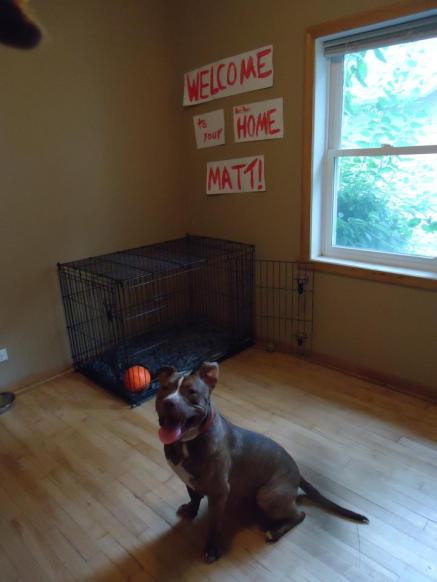
With reactive/selective dogs, I start out with crating and rotating when I bring them into my house with my resident dogs.
What is crate and rotate?
Essentially, it’s keeping the dogs completely physically separate. Each dog has their own safe space (see reactive dog Matt’s old personal room above). It gives them time to get completely used to seeing, hearing, and smelling each other.
The length of time we crate and rotate varies with each dog and situation. It can be for just a couple of days, it’s usually a week or two, but sometimes it can be a couple of months. It doesn’t mean that they are only in their crate or that is the only time they see each other. It just means if I am not actively training them, they don’t have access to each other.
Reactive dogs can become used to seeing a stationary dog during their crate and rotate experience, but often times a moving dog is a whole lot more exciting. I never introduce dogs after only crating and rotating because it can lull you into a little bit of a false sense of security. Your reactive dog can be completely non-reactive with another new dog in the house, but the whole ballgame changes when suddenly that dog is let out of the kennel and can make contact with them (rudely greet, overwhelm, etc).
Additionally, I almost think there is a difficult to find ‘sweet spot’ with regards to how long to crate and rotate. You want the dogs to be used to seeing/smelling/hearing each other but you don’t want them to start to only think of the other dog as a non-interactive fixture. If you crate and rotate for too long without any other interactions between the dogs, it can take longer to integrate them because of the expectation they may have that the new dog doesn’t move.
Mental Toll
It is HARD WORK to successfully, humanely crate and rotate.
For the dogs, it can be difficult to not always be right with their human. It can be extremely difficult or impossible to do with dogs with separation anxiety because the stress level can be high. Depending on how many people are in your household, they may have to spend 50% less time with humans. To make it easier, make sure your dog thinks of the kennel as a happy place (it’s nice to train them to it before-hand). Play crate games. Enhance their experience by freezing Kongs with goodies and only giving treats and food to them in their crate. Exercise them as much as possible. Cuddle with them and spend as much time with them as you can so they don’t get lonely.
For the human, the hard work is spending enough interactive time with each of the dogs, making sure all the barriers are in place every time you move around the house or let a dog out. Personally, crate and rotate is hard because I feel way too guilty to do ANYTHING else other than spend time with dogs when they have to be 100% separate. People have to take care of themselves too, otherwise your frustration can get the best of you and your fuse can get shorter and shorter. It’s so much nicer to crate and rotate with two or more people that can be TRUSTED to follow the protocol. Having friends/family over is often difficult, because you have to make sure they are going to be reliable to close the door behind them. When we have company I am on alert for potential management pitfalls and the confusion/disdain that non-dog people have for our ‘chaotic’ household.
Like I said before, the rules for crate and rotate include:
- To be left home alone, they need a minimum of two solid barriers between them. I usually do three. At least one of the barriers needs to completely block vision. I typically recommend giving each dog their own room and kenneling them inside that room. For the dog I don’t know as well, I always kennel them. My own personal dog I may just keep in a separate bedroom.
- Make sure the kennel is secure. If you have a reactive dog, often times they are a little on the anxious side. If they aren’t kennel trained, they may really test the kennel and potentially escape it. I know of a dog that broke out of a kennel, chewed through a solid wood door and killed another dog that was loose in the house. A secure kennel is a MUST. I always zip-tie the crap out of mine just in case.

Pingback: Chapter Fifteen | uwdogs.com.au·